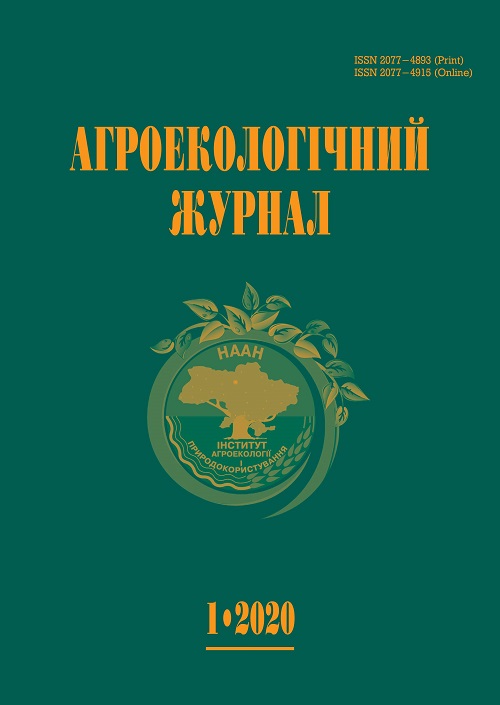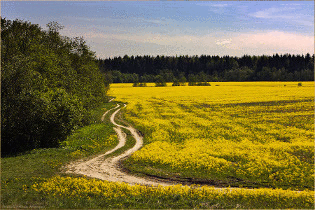Сукцесійна концепція мікробіому ґрунту
DOI:
https://doi.org/10.33730/2077-4893.1.2020.201267Ключові слова:
сукцесія, концепція, мікроорганізми, динаміка, ґрунт, екосистемаАнотація
Проаналізовано існуючі підходи вивчення мікробних сукцесій у ґрунті. Розглянуто кон- цептуальні моделі динаміки екзогенних і ендогенних сукцесій в угрупованнях ґрунтових мікроорганізмів природних і трансформованих екосистем. Встановлено загальні за- кономірності змін у функціональній і таксономічній структурі угруповань ґрунтових мікроорганізмів на різних стадіях сукцесійного процесу. Відзначено, що біомаса ґрунтових мікроорганізмів і філогенетичне різноманіття є маркерами сукцесійних процесів у мікробіомі ґрунту. На основі довготривалих моніторингових досліджень мікробіому ґрунту природних і трансформованих екосистем запропоновано деталізовані концептуальні моделі сукцесійної динаміки. Відповідно до запропонованої концепції виділено п’ять основних категорій сукцесій із вказаними маркерами і драйверами сукцесійних процесів у різних типах екосистем.
Посилання
Iutinskaya, G.A., Ponomarenko, S.P., Andreyuk, Ye.I. et al. (2010). Bioregulyatsiya mikrobno-rastitel’nykh sistem: monografiya [Bioregulation of microbial-plant systems]. G.A. Iutinskoy, S.P. Ponomarenka (Eds.). Kyiv: Nichlava [in Russian].
Aislabie, J., Deslippe, J.R. (2013). Soil microbes and their contribution to soil services. Soil microbial diversity. Ecosystem services in New Zealand — conditions and trends. Manaaki Whenua Press, Lincoln, New Zealand [in English].
Bardgett, R.D., Usher, M.B. (2005). Biological diversity and function in soils. Cambridge Univ., Press [in English].
Patyka, V.P., Symochko, L.YU. (2013). Mikrobiolohichnyy monitorynh gruntu pryrodnykh ta transformovanykh ekosystem Zakarpattya Ukrayiny [Microbiological monitoring of natural and transformed ecosystems in Transcarpathia, Ukraine]. Mikrobiolohichnyy zhurnal — Microbiology Journal, 2, 21–31 [in Ukrainian].
Wall, D.H. (2012). Soil Ecology and Ecosystem Services. Oxford University Press [in English].
Vancura, V., Kunc, F. (Eds.). (1988). Soil microbial associations. Control of structures and functions. Elsevier [in English].
Steinweg, J.M., Dukes, J.S., Wallenstein, M.D. (2012). Modeling the effects of temperature and moisture on soil enzyme activity: linking laboratory assays to continuous field data. Soil Biol. Biochem, 55, 85–92 [in English].
Wang, G., Post, W.M. (2012). A theoretical reassessment of microbial maintenance and implications for microbial ecology modeling. FEMS Microbiol. Ecol, 81, 610–617 [in English].
Zornoza, R., Guerrero, C., Mataix-Solera, J. et al. (2009). Changes in soil microbial community structure following the abandonment of agricultural terraces in mountainous areas of Eastern Spain. Appl Soil Ecol, 42, 315–323 [in English].
Symochko, L. Hamuda, H.B. (2015). Microbial monitoring of soil as additional tools for conservation biology. Obuda University e-Bulletin, 5(1), 177–185 [in English].
Aleksandrova, V.D. (1964). Izucheniye smen rastitel’nogo pokrova [Study of land cover changes]. Polevaya geobotanika [Field Geobotany (Vol. 4)]. Moskva, Leningrad: Nauka [in Russian].
Mirkin, B.M., Rozenberg, G.S. (1978). Fitotsenologiya. Printsipy i metody [Phytocenology. Principles and Methods]. Moskva: Nauka [in Russian].
Rabotnov, T.A. (1983). Fitotsenologiya [Phytocenology]. Moskva: Izd-vo Mosk. un-ta [in Russian].
Sukachev, V.N. (1942). Ideya razvitiya v fitotsenologii [The idea of development in phytocenology]. Sov. Botan, 1/3, 5–17 [in Russian].
Sukachev, V.N. (1964). Osnovnyye ponyatiya lesnoy biogeotsenologii [Basics concepts of forest biogeocenology]. Osnovy lesnoy biogeotsenologii [Basis of forest boigeocenology]. — Moskva: Nauka [in Russian].
Tansley, A.G. (1935). The ust and abuse of vegetational concepts and terms. Ecology, 16(3), 284–307 [in English].
Pace, N.R. (1997). A molecular view of microbial diversity and the biosphere. Science, 276, 734–739 [in English].
Fedorov, V.D., Gil’manov, T.G. (1980). Ekologiya [Ecology]. Moskva: Izd-vo Mosk. un-ta [in Russian].
Clements, F.E. (1973). Plant succesion and indicators. New-York: Hafner press [in English].
Sochava, V.B. (1961). Voprosy klassifikatsii rastitel’nosti, tipologii fiziko-geograficheskikh fatsiy i biogeotsenozov [Classification of vegetation, typology of physical-geographical facies and biogeocenoses]. Tr. In-ta biol. Ural’sk. fil. AN SSSR — Work’s In-t of boil Phil in Ural’sk ASc USSR, 27, 5–22. [in Russian].
Yaroshenko, P.D. (1961). Geobotanika. Osnovnyye ponyatiya, napravleniya i metody. [Geobotany. Basic concepts, directions and methods.]. Moskva; Leningrad: Izd-vo AN SSSR [in Russian].
Dylis, N.V. (1978). Osnovy biogeotsenologii. [Fundamentals of Biogeocenology]. Moskva: Izd-vo Mosk. un-ta [in Russian].
Sukachev, V.N. (1942). Ideya razvitiya v fitotsenologii [The idea of development in phytocenology]. Sov. Botan, 1/3, 5–17 [in Russian].
Razumovskiy, S.M. (1981). Osnovnyye zakonomernosti suktsessionnoy dinamiki fitotsenozov [The main laws of succession dynamics of phytocenoses]. Modelirovaniye biogeotsenoticheskikh protsessov [Modeling of biological processes]. Moskva: Nauka [in Russian].
Razumovskiy, S.M. (1981). Zakonomernosti dinamiki biogeotsenozov [Patterns of dynamics of biogeocenoses]. Moskva: Nauka [in Russian].
Razumovskiy, S.M. (1999). Izbrannyye trudy [Selected Works]. Moskva: KMK Scientific Press [in Russian].
Davis, M.B., Shaw, R.G. (2001). Range shifts and adaptive responses to Quaternary climate change. Science, 292, 673–679 [in English].
Delmoral, R., Bliss, L.C. (1993). Mechanisms of primary succession e insights resulting from the eruption of Mount St-Helens. Adv. Ecol. Res., 24, 1–66 [in English].
Chapin, F.S., Walker, L.R., Fastie, C.L., Sharman, L.C. (1994). Mechanisms of primary succession following deglaciation at Glacier Bay Alaska. Ecol. Monogr., 64, 149–175 [in English].
Turner, M.G., Baker, W.L., Peterson, C.J., Peet, R.K. (1998). Factors influencing succession: lessons from large, infrequent natural disturbances. Ecosystems, 1, 511–523 [in English].
Sigler, W.V., Crivii, S., Zeyer, J. (2002). Bacterial succession in glacial forefield soils characterized by community structure, activity and opportunistic growth dynamics. Microb. Ecol., 44, 306–316 [in English].
Strickland, M., Lauber, C., Fierer, N., Bradford M. (2009). Testing the functional significance of microbial community composition. Ecology, 90, 441–451 [in English].
Nemergut, D.R., Anderson, S.P., Cleveland, C.C., Martin, A.P., Miller, A.E., Seimon, A., Schmidt, S.K. (2007). Microbial community succession in unvegetated, recently-deglaciated soils. Microb. Ecol., 53, 110–122 [in English].
Powlson, D.S., Brookes, P.C., Christensen, B.T. (1987). Measurement of soil microbial biomass provides an indication of changes in total soil organic matter due to straw incorporation. Soil Biology & Biochemistry, 19(2), 159–164 [in English].
Sakamoto, K., Oba, Y. (1994). Effect of fungal to bacterial biomass ratio on the relationship between CO2 evolution and total soil microbial biomass. Biol Fertil Soils, 17(1), 39–44 [in English].
Bailey, V.L., Smith, J.L., Bolton, H.J. (2002). Fungalto-bacterial biomass ratios in soils investigated for enhanced carbon sequestration. Soil Biol Biochem, 34, 997–1007 [in English].
Heger, T.J., Imfeld, G., Mitchell, E.A.D. (2012). Bioindication in Soil Ecosystems. European Journal of Soil Biology, 49, 1–118 [in English].
Brussaard, L., de Ruiter, P.C., Brown, G.G. (2007). Soil biodiversity for agricultural sustainability. Agriculture Ecosys. Environ, 121, 233–244 [in English].
Demiyanyuk, O.S., Symochko, L.YU., Tertychna, O.V. (2017). Suchasni metodychni pidkhody do otsinyuvannya ekolohichnoho stanu gruntu za aktyvnistyu mikrobiotsenozu. [Modern methodical approaches to evaluation the ecological condition of soil by microbial activity]. Pytannya bioindykatsiyi ta ekolohiyi — Questions of bioindication and ecology, 22, 3(6), 55–68 [in Ukrainian].
Fierer, N., Bradford, M., Jackson, R. (2007). Toward an ecological classification of soil bacteria. Ecology, 88, 1354–1364 [in English].
Fierer, N. et al. (2010). Changes through time: integrating microorganisms into the study of succession. Research in Microbiology, 20, 1–8. DOI:10.1016/j.resmic.2010.06.002 [in English].
Rui, J.P., Peng, J.J., Lu, Y.H. (2009). Succession of bacterial populations during plant residue decomposition in rice field soil. Appl. Environ. Microbiol., 75, 4879–4886. [in English].
Forney, L.J., Liu, W.T., Guckert, J.B., Kumagai, Y., Namkung, E., Nishihara, T., Larson, R.J. (2001). Structure of microbial communities in activated sludge: potential implications for assessing the biodegradability of chemicals. Ecotoxicol. Environ. Saf., 49, 40–53 [in English].
Schutte, U.M.E., Abdo, Z., Bent, S.J., Williams, C.J., Schneider, G.M., Solheim, B., Forney, L.J. (2009). Bacterial succession in a glacier foreland of the High Arctic. ISME J, 3, 1258–1268 [in English].
Nakasaki, K., Nag, K., Karita, S. (2005). Microbial succession associated with organic matter decomposition during thermophilic composting of organic waste. Waste Manag. Res., 23, 48–56 [in English].
Symochko, L.Y., Fizer, A.I. (2017). Authentic soil microbial communities in primeval forest ecosystems of Uzhanskyi National Nature Park. Gruntoznavstvo, 18(3–4), 51–56. DOI: 10.15421/041715 [in English].
Symochko, L.Yu., Kalinichenko, A.V. (2018). Soil Microbiome of Primeval Forest Ecosystems in Transсarpathia. Mikrobiolohichnyi Zhurnal — Microbiology Journal, 80(3), 3–14. DOI: https://doi.org/10.15407/microbiolj80.03.003 [in English].
Symochko, L.YU., Demyanyuk, O.S. (2018). Mikrobiom gruntu kul’turnykh roslyn za riznykh ahrotekhnolohiy [Soil microbiome of cultural plants under different agrotechnologies]. Ahroekolohichnyy zhurnal — Agroecological Journal, 2, 87–93 [in Ukrainian].
##submission.downloads##
Опубліковано
Номер
Розділ
Ліцензія
Авторське право і ліцензування
Умови ліцензії: автори зберігають авторські права і надають журналу право першої публікації з роботою, одночасно ліцензованої за ліцензією Creative Commons Attribution License International CC-BY, яка дозволяє іншим ділитися роботою з визнанням авторства роботи і початкової публікації в цьому журналі.
Якщо стаття прийнята до публікації в «Агроекологічний журнал», автор повинен підписати угоду про передачу авторських прав. Угода відправляється на поштову (оригінал) або адресу електронної пошти (відсканована копія) редакції журналу.
Цією угодою автор підтверджує, що представлені матеріали:
- не порушують авторських прав інших осіб або організацій;
- раніше не публікувались в інших видавництвах і не були представлені для публікації в інших виданнях.
Автор передає редакції «Агроекологічного журналу» права на:
- публікації статті українською (англійською) мовою і поширення її друкованої копії;
- поширення електронної копії статті, а також електронної копії перекладу статті на англійську мову (для статей українською мовою), будь-якими електронними засобами (розміщення на офіційному сайті журналу, електронних баз даних, сховищ тощо) друкована копія перекладу.
Автор залишає за собою право без згоди редакції та засновників:
- Використовувати матеріали статті повністю або частково в ознайомлювальних цілях.
- Використовувати матеріали статті повністю або частково для написання власних дисертацій.
- Використовувати матеріали статті для підготовки тез доповідей, доповідей конференцій, а також усних доповідей.
- Додати електронні копії статті (включаючи остаточну електронну копію, завантажену з офіційного сайту журналу) за адресою:
- персональні веб-ресурси всіх авторів (веб-сайти, веб-сторінки, блоги тощо);
- веб-ресурси установ, в яких працюють автори;
- некомерційні веб-ресурси відкритого доступу (наприклад, arXiv.org).
У всіх випадках наявність бібліографічного посилання на статтю або гіперпосилання на її електронну копію на офіційному сайті журналу є обов'язковим.



